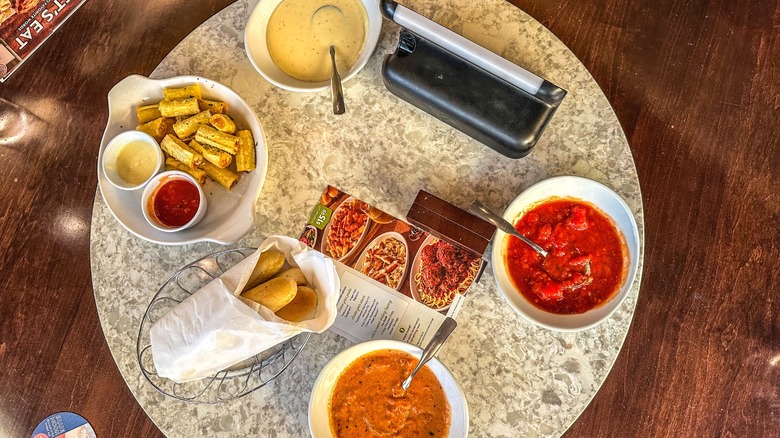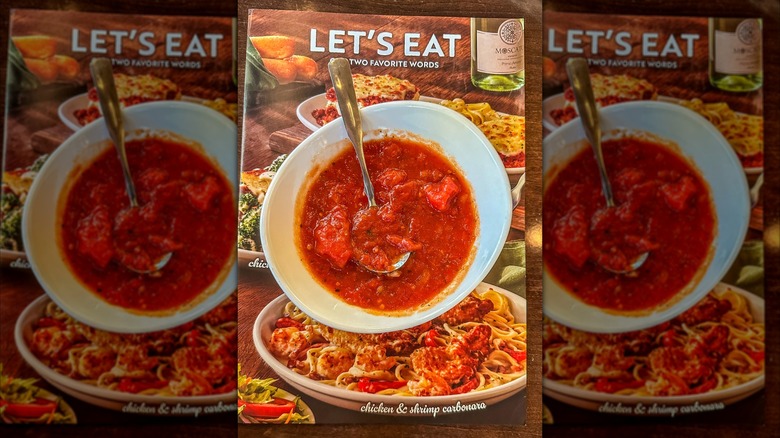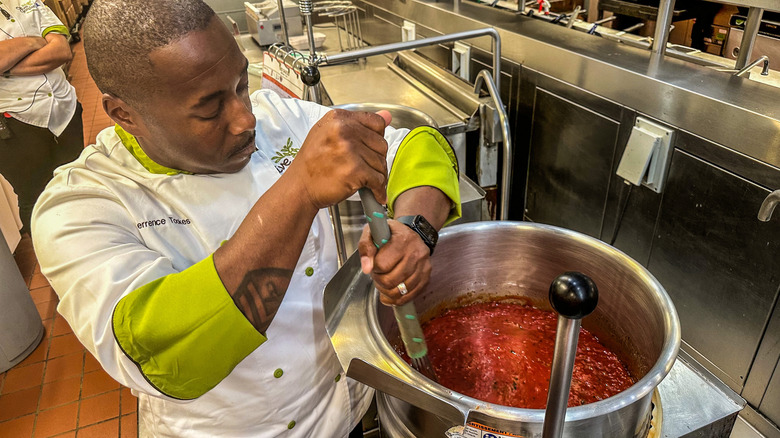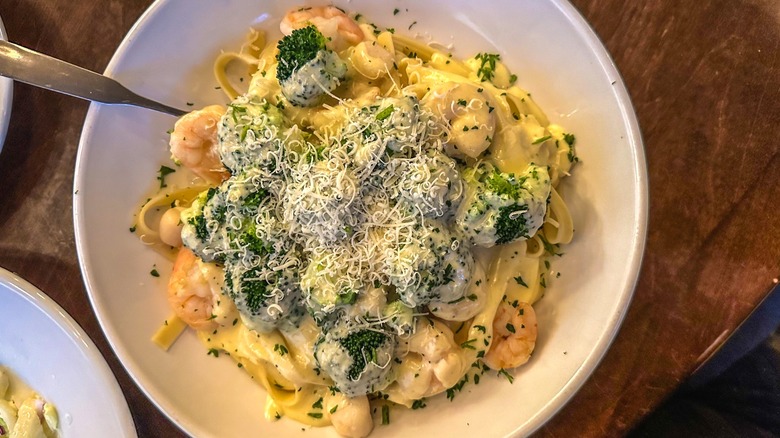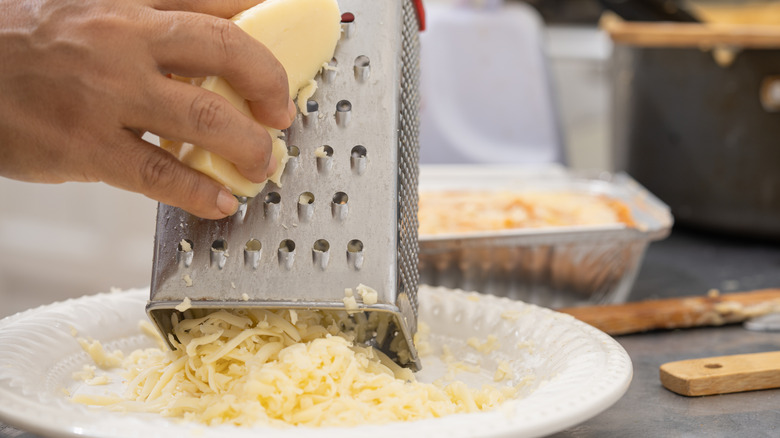Olive Garden Gave Us The Inside Scoop On The Making Of Its Classic Sauces
When it comes to nationwide restaurant chains, no matter the cuisine, there's an assumption that speed takes precedence over quality. While this may be true for some big names, Olive Garden is doing its best to set a different standard. With over 900 locations nationwide, Olive Garden strives to deliver a consistent product that will keep guests coming back for more, and at the forefront of this consistency is the sauce. According to Terrence Tookes, executive chef for Olive Garden, the chefs at each Olive Garden location are making those sauces fresh, and you won't find a single jar or can of premade sauce. From marinara sauce to creamy Alfredo, Olive Garden is making its classic sauces fresh every day, and we got an inside look at how the chain does it.
Ensuring the sauces at every Olive Garden location are consistent isn't an easy task, but it's one that chef Tookes and his team are proud of working toward. The recipes for Olive Garden's classic sauces aren't overly complicated, and that's kind of the point. Made with simple, fresh ingredients, these sauces are meant to please any and all palates, and it's this focus on simplicity and un-complicated flavors that allows Olive Garden to deliver a dish, whether it's chicken Parmesan or simply a bowl of pasta, with a freshly prepared sauce that the company can stand behind.
Marinara sauce is made fresh every day
While each Olive Garden kitchen doesn't come with an Italian nonna in the back, stirring sauce all day, every day, there is a member of the kitchen staff responsible for preparing and perfecting each sauce. "We do extensive training, and all 920 restaurants get the same recipes. Everyone knows the procedure," said chef Terrence Tookes. "Our sauciers are some of the oldest tenured people in the restaurants. They specialize in the sauce."
Olive Garden's marinara sauce starts with a base using fresh tomatoes which are harvested in Fresno, California, and then processed, vacuum packed, and shipped to each and every Olive Garden location. Once that marinara base arrives at the restaurant, it's time to make the sauce. The process starts with hot oil in a large pot and a battuto — a concentrated mixture prepared with garlic, onions, and a variety of herbs and spices that add flavor and texture to the sauce — which is cooked in the hot oil, allowing it to bloom and release all its flavor and aroma. The fresh tomato sauce base is added to the cooked battuto and then brought up to 185 degrees Fahrenheit and simmered for 20 minutes. Once the sauce reaches that 20-minute mark and has developed those crucial points of flavor and consistency, it's ready to serve.
Meat sauce uses marinara as the base
Ask anyone who loves meat sauce: The best ones are simmered for hours to develop deep, rich flavors that can't be faked or made in a flash. A good Italian Sunday sauce isn't actually made on Sunday; it's most likely getting made the day before. By the time it's lovingly spooned over a bowl of pasta the next day, it's reached peak perfection. The reality for Olive Garden, however, is that this process isn't really possible at scale.
Similarly to the marinara sauce, Olive Garden's meat sauce starts at the factory level, and then the rest of the work is done on-site in the kitchen. Again, a battuto is used in the kitchen to kick up the flavors in the meat sauce, but the tomato base is tweaked at the factory to work for the meat sauce rather than the standard marinara, this time adding a beef base and extra seasonings to get that meaty quality. The pork and beef for the sauce are seared and cooked in the kitchen, combined with the tomato base, cooked to 185 degrees Fahrenheit, and simmered for 20 minutes before being served. The fat from the browned-off meats helps to add a deeper, more unctuous flavor. "We use a pressure-cooking process to build those deep flavors that we look for out of meat sauce and you wouldn't get if you put meat and marinara together in your house," said chef Terrence Tookes.
The Alfredo sauce is a lesson in simplicity
When it comes to pasta decadence, nothing hits quite like a creamy, dreamy Alfredo sauce. That said, not all Alfredo sauces are created equal, and it's almost too easy to screw it up and go from luxurious, velvety Alfredo to a gloopy, milky mess. Chef Terrence Tookes and his culinary team at Olive Garden have cracked the code for creating an Alfredo that requires only a handful of ingredients — Parmesan cheese, salt, pepper, garlic, starch, milk, heavy cream, and butter — and won't break (aka when the fat and liquid separate) while cooking. The secret? The Alfredo is cooked in a double boiler pot that uses steam rather than direct heat to cook the sauce, ensuring an even distribution of heat throughout the sauce and preventing any breakage from occurring during the delicate cooking process.
"We make our marinara sauce in large batches, but the Alfredo we're making fresh consistently throughout the day," said chef Tookes. The saucier who spends their days cooking and perfecting each sauce is in charge of constantly refreshing the Alfredo, guaranteeing that no matter the time of day or how busy the restaurant may be, that sauce is at optimal flavor and texture.
Five-cheese marinara combines two classic sauces into one
Olive Garden's five-cheese marinara sauce is a marriage of two classic sauces: marinara and Alfredo. But, there's more to it than just pouring marinara and Alfredo sauce into a giant pot and giving it a good stir. There's a method to the cheesy madness, starting with the five-cheese blend — ricotta, Parmesan, mozzarella, fontina, and asiago — also known as the "ziti cheese" blend in the kitchen. Marinara is added into that large double boiler pot, followed by Alfredo sauce, with the ziti cheese blend whisked in at the end for maximum cheesiness.
Just like the Alfredo, the five-cheese sauce is prone to breakage because of all that dairy, so to avoid an oily, separated mess, the sauces are both added into the pot hot rather than starting cold. Most importantly, this sauce is also made fresh throughout the day, meaning whenever the five-cheese sauce is ordered, it's most likely part of the freshest batch.
